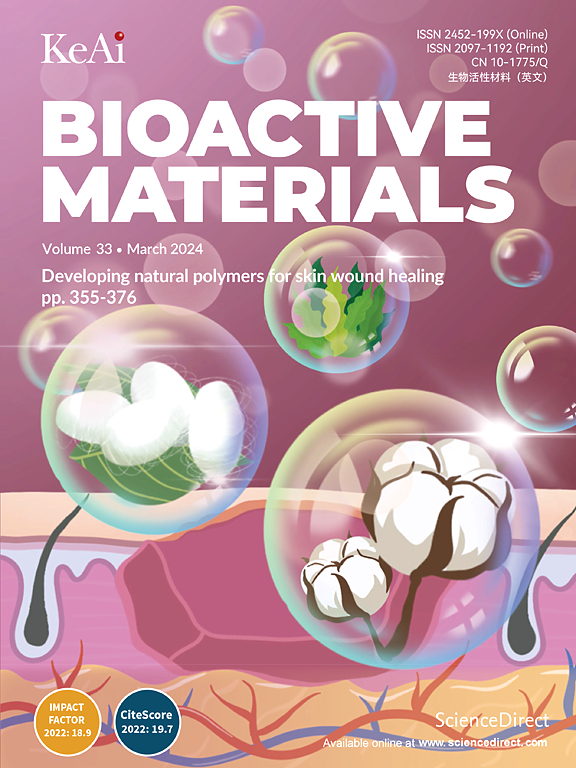Copper doped bioactive glass promotes matrix vesicles-mediated biomineralization via osteoblast mitophagy and mitochondrial dynamics during bone regeneration
IF 18
1区 医学
Q1 ENGINEERING, BIOMEDICAL
引用次数: 0
Abstract
Bone defect repair remains a great challenge in the field of orthopedics. Human body essential trace element such as copper is essential for bone regeneration, but how to use it in bone defects and the underlying its mechanisms of promoting bone formation need to be further explored. In this study, by doping copper into mesoporous bioactive glass nanoparticles (Cu-MBGNs), we unveil a previously unidentified role of copper in facilitating osteoblast mitophagy and mitochondrial dynamics, which enhance amorphous calcium phosphate (ACP) release and subsequent biomineralization, ultimately accelerating the process of bone regeneration. Specifically, by constructing conditional knockout mice lacking the autophagy gene Atg5 in osteogenic lineage cells, we first confirmed the role of Cu-MBGNs-promoted bone formation via mediating osteoblast autophagy pathway. Then, the in vitro studies revealed that Cu-MBGNs strengthened mitophagy by inducing ROS production and recruiting PINK1/Parkin, thereby facilitating the efficient release of ACP from mitochondria into matrix vesicles for biomineralization during bone regeneration. Moreover, we found that Cu-MBGNs promoted mitochondrion fission via activating dynamin related protein 1 (Drp1) to reinforce mitophagy pathway. Together, this study highlights the potential of Cu-MBGNs‐mediated mitophagy and biomineralization for augmenting bone regeneration, offering a promising avenue for the development of advanced bioactive materials in orthopedic applications.

铜掺杂生物活性玻璃通过成骨细胞自噬和骨再生过程中的线粒体动力学促进基质囊泡介导的生物矿化。
骨缺损修复一直是骨科领域的一大难题。人体必需微量元素铜是骨再生的必需元素,但如何在骨缺损中使用以及其促进骨形成的潜在机制有待进一步探索。在这项研究中,通过将铜掺杂到介孔生物活性玻璃纳米粒子(Cu-MBGNs)中,我们揭示了铜在促进成骨细胞线粒体自噬和线粒体动力学中的作用,从而促进无定形磷酸钙(ACP)的释放和随后的生物矿化,最终加速骨再生过程。具体而言,通过在成骨谱系细胞中构建缺乏自噬基因Atg5的条件敲除小鼠,我们首次证实了cu - mbgns通过介导成骨细胞自噬途径促进骨形成的作用。随后,体外研究发现Cu-MBGNs通过诱导ROS生成和募集PINK1/Parkin来增强线粒体自噬,从而促进骨再生过程中ACP从线粒体高效释放到基质囊泡中进行生物矿化。此外,我们发现Cu-MBGNs通过激活动力蛋白相关蛋白1 (dynamin related protein 1, Drp1)来增强线粒体自噬途径,从而促进线粒体分裂。总之,这项研究强调了cu - mbgns介导的有丝分裂和生物矿化在增强骨再生方面的潜力,为骨科应用中先进生物活性材料的开发提供了一条有希望的途径。
本文章由计算机程序翻译,如有差异,请以英文原文为准。
求助全文
约1分钟内获得全文
求助全文
来源期刊

Bioactive Materials
Biochemistry, Genetics and Molecular Biology-Biotechnology
CiteScore
28.00
自引率
6.30%
发文量
436
审稿时长
20 days
期刊介绍:
Bioactive Materials is a peer-reviewed research publication that focuses on advancements in bioactive materials. The journal accepts research papers, reviews, and rapid communications in the field of next-generation biomaterials that interact with cells, tissues, and organs in various living organisms.
The primary goal of Bioactive Materials is to promote the science and engineering of biomaterials that exhibit adaptiveness to the biological environment. These materials are specifically designed to stimulate or direct appropriate cell and tissue responses or regulate interactions with microorganisms.
The journal covers a wide range of bioactive materials, including those that are engineered or designed in terms of their physical form (e.g. particulate, fiber), topology (e.g. porosity, surface roughness), or dimensions (ranging from macro to nano-scales). Contributions are sought from the following categories of bioactive materials:
Bioactive metals and alloys
Bioactive inorganics: ceramics, glasses, and carbon-based materials
Bioactive polymers and gels
Bioactive materials derived from natural sources
Bioactive composites
These materials find applications in human and veterinary medicine, such as implants, tissue engineering scaffolds, cell/drug/gene carriers, as well as imaging and sensing devices.
 求助内容:
求助内容: 应助结果提醒方式:
应助结果提醒方式:


